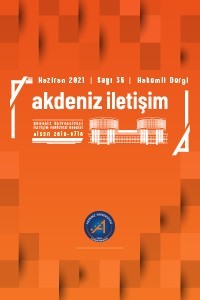Türkiye'de Ulusal Kanallarda Yayınlanan Dizi Fragmanlarında Şiddetin Sunumu
THE REPRESENTATION OF VIOLENCE IN TV SERIES’ TRAILERS BROADCASTED BY TURKEY’S NATIONAL CHANNELS
Series Violence, Television,
___
- Berkowitz, L. (1970). “The contagion of Violence. An SAER Mediational Analysis of Some Effects of Observed Aggression”. Nebraska Symposion on Motivation, Vol. 18, 95-135
- Eron, L. D. (1994). “Theories of aggression: From drives to cognitions”. L. R. Huesmann (Ed.), Aggressive behavior: Current perspectives, New York: Plenum Press, 3-11
- Hurrelmann, K. ve Palentien, C. (1995). “Gewalt als “soziale Krankheit” der Gesellschaft.
- Galtung, J. (1975). “Strukturelle Gewalt. Beiträge zur Friedens- und Konfliktforschung”,Reinbek bei Hamburg.
- Gerbner, G. (1996).”Chairman Znaimer’s Sensual Pagan Torrent”, Canadian Journal of Communication, Vol. 21, No.1, s.13-17
- Güleç H., Topaloğlu M., Ünsal D., Altıntaş M.. (2012) „Bir Kısır döngü Olarak Şiddet, Psikiyatride Güncel Yaklaşımlar“, Current Approaches in Psychiatry 4 (1), s.112- 137
- KIM Araştırma Raporu (2009), “KIM Studie 2008 Kinder und Medien, Computer und İnternet”, Medienpaedagogischer Forschungsverbund Südwest, Landesanstalt für Kommunikation Baden-Württemberg (LFK). Stuttgart
- Kocacık F. (2001). “Şiddet Olgusu Üzerine”, C.Ü. İktisadi ve İdari Bilimler Dergisi, Cilt 2, Sayı 1, s.1-7
- Krahé, B. (2001). “Media violence and aggression”, The social psychology of aggression, Psychology Press, Hove
- Kunczik, M. (1993). “Gewalt im Fernsehen”, Media Perspektiven 3. Sayı, 98-107
- RTÜK(2018).Televizyon İzleme Eğilimleri Araştırması Raporu https://www.rtuk.gov.tr/assets/Icerik/AltSiteler/televizyonizlemeegilimleriarastirmasi2018.pdf. Erişim tarihi: 07.05.2019.
- Selg, H. (2003). “Mediengewalt und ihre Auswirkungen auf Kinder. Stellungnahme zueiner alten Streitfrage und zu angeblich kontroversen Befunden”, Rheinhardt-Verlag, München.
- Şirin, M. R. (2011).”Şiddet, Televizyon ve Çocuk Dostu Medya”, Çocuk Hakları Medya El Kitabı, İstanbul ;Çocuk Yayınları Vakfı
- Tezcan, M. (1996). “Bir Şiddet Ortamı Olarak Okul”, Cogito, Kış-Bahar, Yapı Kredi Yayınları, 6-7.
- Theunert, H. (1996). “Gewalt in den Medien - Gewalt in der Realität. Gesellschaftliche Zusammenhänge und pädagogisches Handeln”, München
- Theunert, H. (1996). “Gewalt in den Medien - Gewalt in der Realität. Gesellschaftliche Zusammenhänge und pädagogisches Handeln”, München
- Ünsal, A. (1996).“Genişletilmiş Bir Şiddet Tipolojisi”, Cogito. sayı 6-7. Kış-Bahar. 29-36.
- Yayın Aralığı: Yılda 3 Sayı
- Başlangıç: 2003
- Yayıncı: Akdeniz Üniversitesi
Dijital İletişim Perspektifinden Destinasyon Markalaşması:Kuşadası’na yönelik bir inceleme
Alışıldık Tanımlamaların Gölgesinde İslami İnancın Batı Sineması’nda Yeniden Sunumu Taken 2
Mehmet Ali SEVİMLİ, Metin KASIM
Post-Yugoslav Sineması’nda Savaş Konulu Filmlerde Toplumsal Fantezi: “Düşman”
Türkiye'de Ulusal Kanallarda Yayınlanan Dizi Fragmanlarında Şiddetin Sunumu
Seda SÜNBÜL OLGUNDENİZ, Pınar ÖZGÖKBEL BİLİS
Anne-Bebek Kategorisi Kapsamında Markalama Stratejilerinde Nüfuz Pazarlamanın Önemi
Küfür ve Argonun Gündelik İletişimdeki Yeri (Üniversite Öğrencileri Özelinde Bir Alan Araştırması)
Netflix’in İlk Türk Dizisi “Hakan Muhafiz” Üzerine Bir Alımlama Analizi
Sibel KARADUMAN, Elif Pınar ACİYAN
Sosyal Medya Davranışları Ölçeğinin Türkçe Formunun Geliştirilmesi: Geçerlik ve Güvenirlik Çalışması
